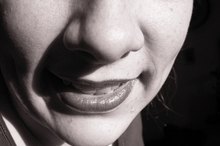What does fact checked mean?
At Healthfully, we strive to deliver objective content that is accurate and up-to-date. Our team periodically reviews articles in order to ensure content quality. The sources cited below consist of evidence from peer-reviewed journals, prominent medical organizations, academic associations, and government data.
The information contained on this site is for informational purposes only, and should not be used as a substitute for the advice of a professional health care provider. Please check with the appropriate physician regarding health questions and concerns. Although we strive to deliver accurate and up-to-date information, no guarantee to that effect is made.
TMJ Exercises & Physical Therapy
Temporomandibular joint disease, commonly referred to as TMJ, is a disorder that affects the connective joint at the jawline. TMJ is generally caused by grinding your teeth or as result of arthritis or a jaw injury. TMJ often causes severe pain and stiffness in the jaw. With moderate treatment and physical therapy, the severity of TMJ symptoms can be decreased.
If you are experiencing serious medical symptoms, seek emergency treatment immediately.
Significance
In addition to pain, if left untreated, TMJ can cause the jaw to lock, making it difficult to open and close the mouth. In addition, it can affect the alignment of your jaw, causing an uneven bite.
Medications
TMJ Exercises for Slipped Disc
Learn More
TMJ is typically treated with a combination of medications for pain symptoms. Pain can generally be treated with over-the-counter medications. However, if your pain become elevated, your doctor can prescribe a prescription pain medication. Patients with severe cases of TMJ may also take a muscle relaxer, to help loosen the jaw muscles and prevent locking or labored movement.
- TMJ is typically treated with a combination of medications for pain symptoms.
- Patients with severe cases of TMJ may also take a muscle relaxer, to help loosen the jaw muscles and prevent locking or labored movement.
Physical Therapy
In addition, your physician may recommend that you participate in physical therapy to strengthen the jaw muscles and increase flexibility in the temporomandibular joint. Exercises such as the "max opening" are commonly recommended for TMJ patients 2. To perform this exercise, open your mouth as wide as you can. Place your hand on your chin and gently push to increase the opening. Hold for up to 30 seconds and release. You may feel a slight pull, however you should not feel pain. If you do, release the stretch and rest your jaw. The max opening should be repeated up to four times per day, every day.
You can also try the "lateral movement" exercise. For the left lateral movement, start by sliding your jaw to the left as far as you can. Place your right hand on the right side of your face and gently push the jaw to the left for an additional stretch. Hold for 30 seconds and release. You should feel a stretch or pull, but you shouldn’t experience pain. Then, perform a right lateral stretch, sliding and gently pushing your jaw to the right. Repeat movement on each side four times, up to four times per day.
- In addition, your physician may recommend that you participate in physical therapy to strengthen the jaw muscles and increase flexibility in the temporomandibular joint.
- Place your hand on your chin and gently push to increase the opening.
Self Care
Exercises for Jaw Tension
Learn More
Supplement your treatment with some self-care. Lightly massage your jaw throughout the day, to prevent it from becoming stiff. Massaging your jaw serves two purposes; it is therapeutic for the jaw joints and muscles, yet also relaxing for you. Use your fingertips to massage the area in front of and below your ears in a circular motion to loosen the muscles. Applying warm compresses can also help to relieve discomfort.
- Supplement your treatment with some self-care.
- Use your fingertips to massage the area in front of and below your ears in a circular motion to loosen the muscles.
Stress Management
MayoClinic.com indicates that some patients develop TMJ symptoms as a result of stress 1. In times of stress, they may clench their jaws or grind their teeth. Managing your stress and ending these bad habits can help to prevent the development of TMJ as well as help to reduce the severity of your symptoms.
Related Articles
References
Writer Bio
Shemiah Williams has been writing for various websites since 2009 and also writes for "Parle Magazine." She holds a bachelor's degree in business and technology and a master's degree in clinical psychology. Williams serves as a subject matter expert in many areas of health, relationships and professional development.








